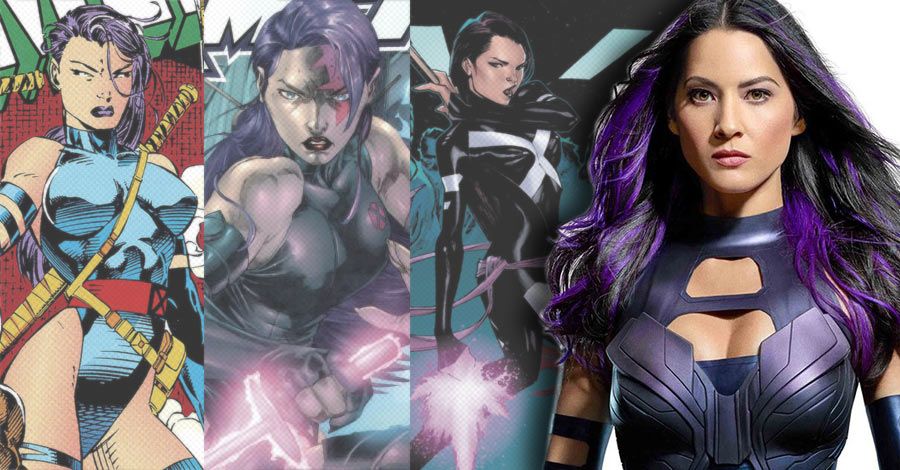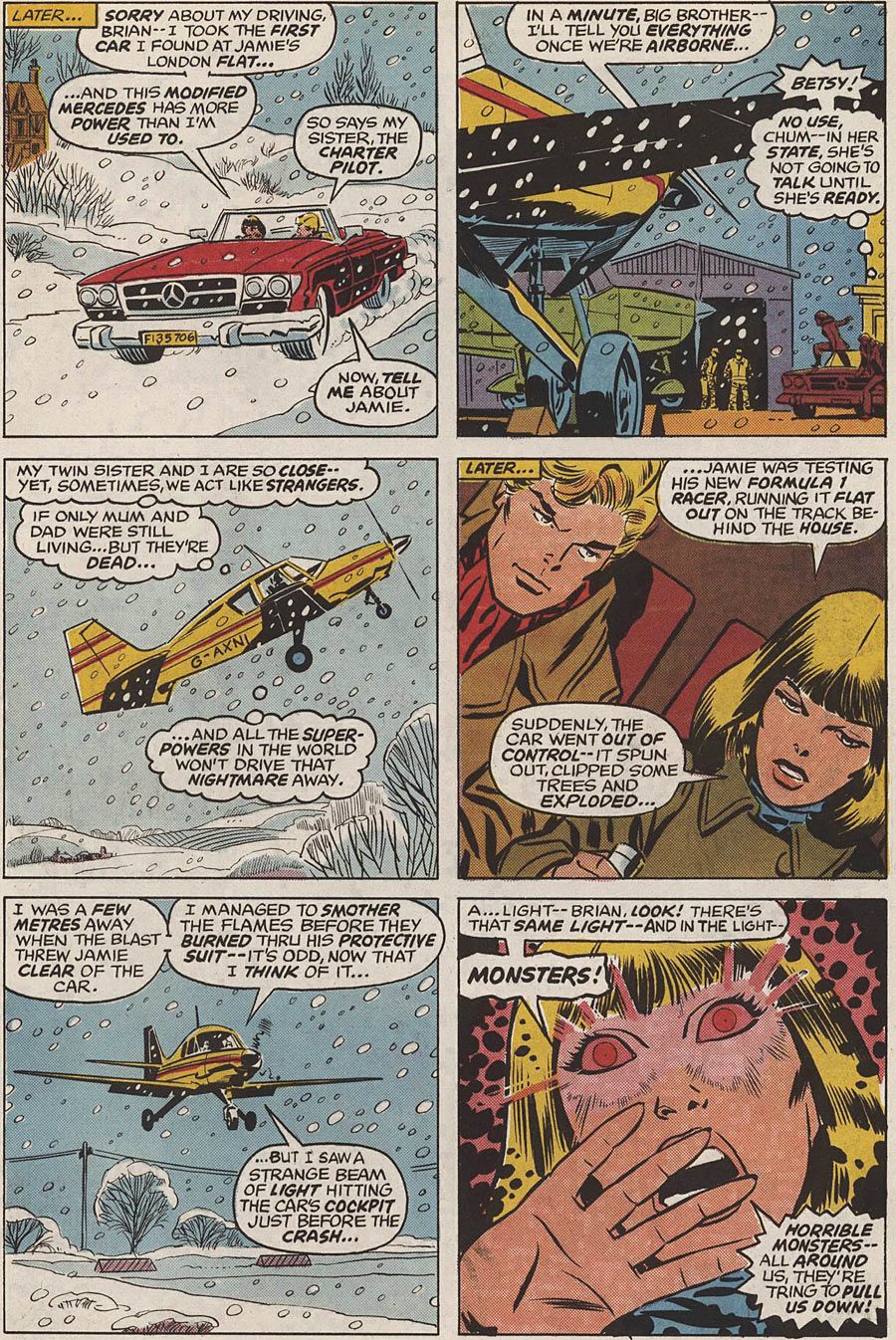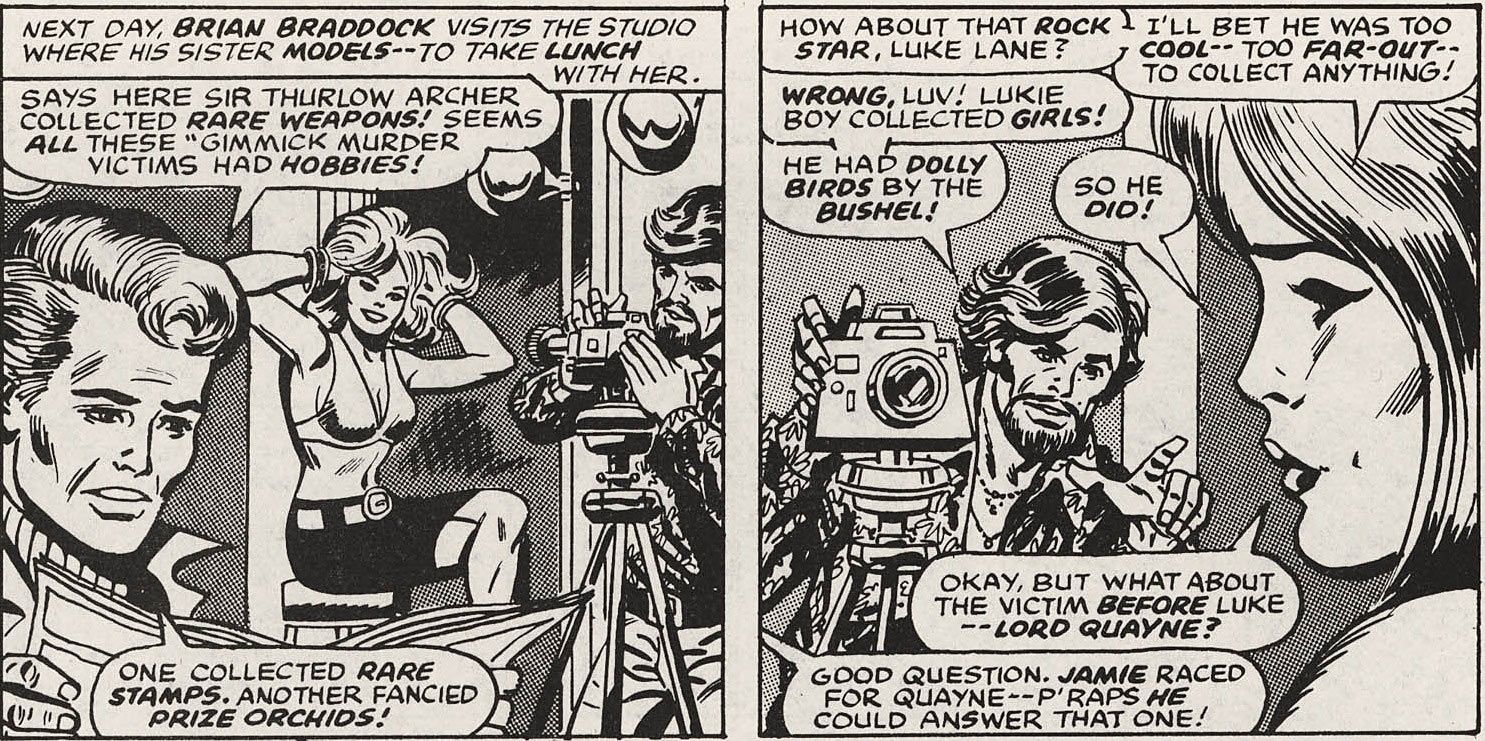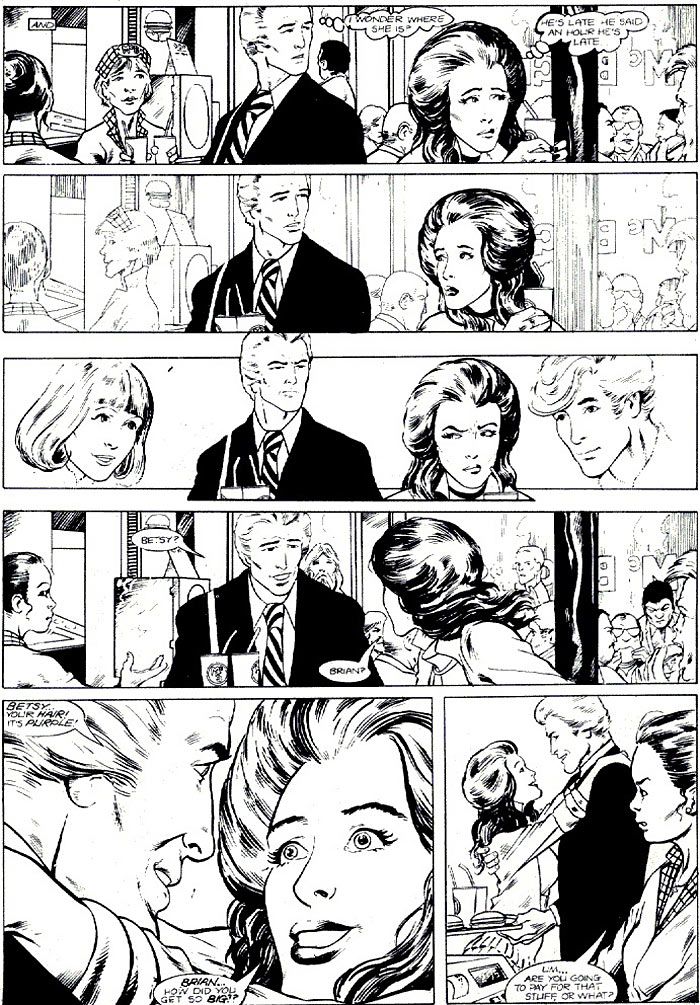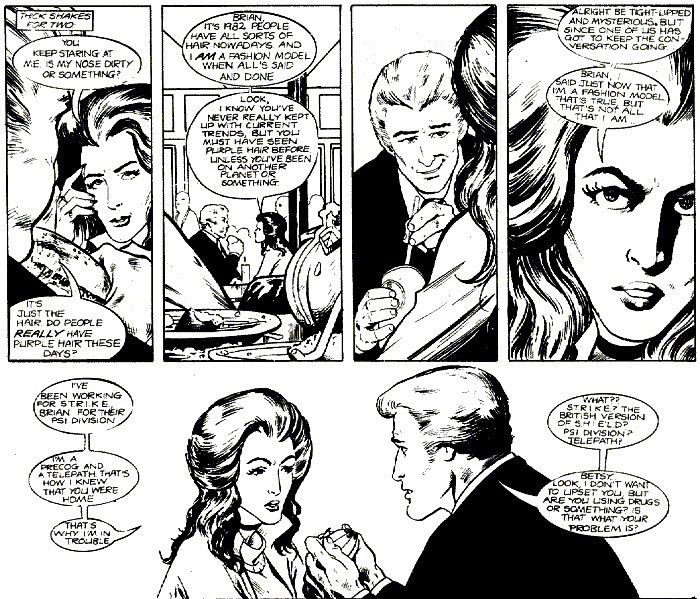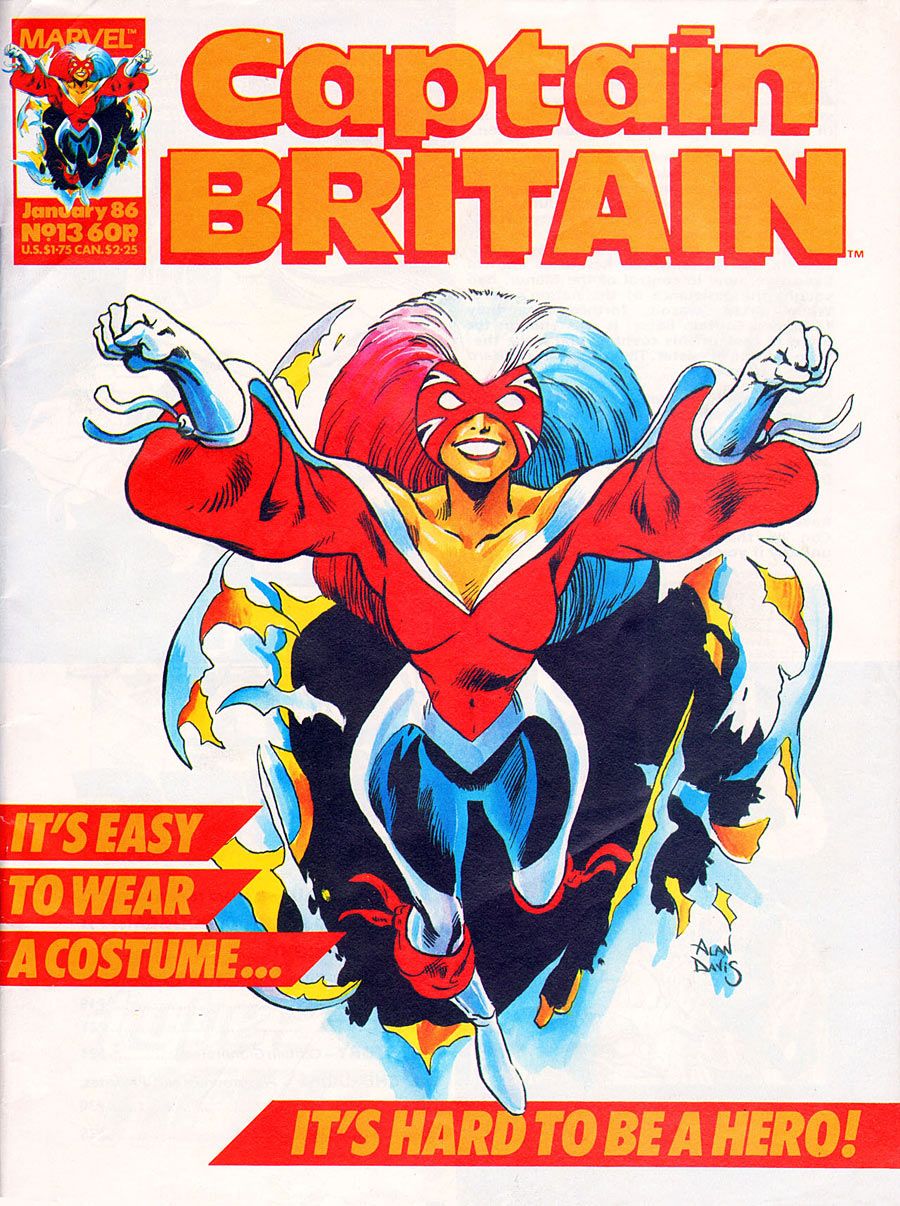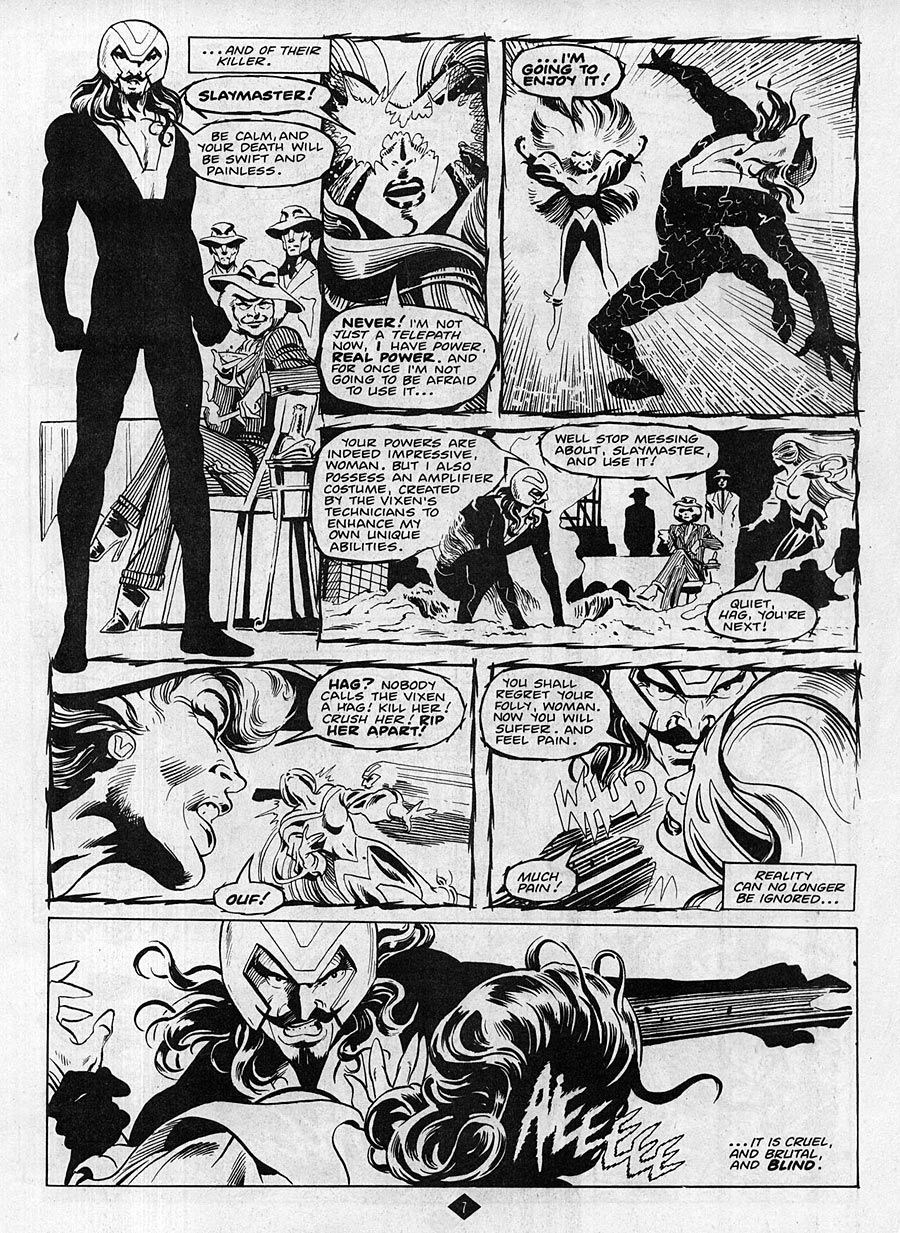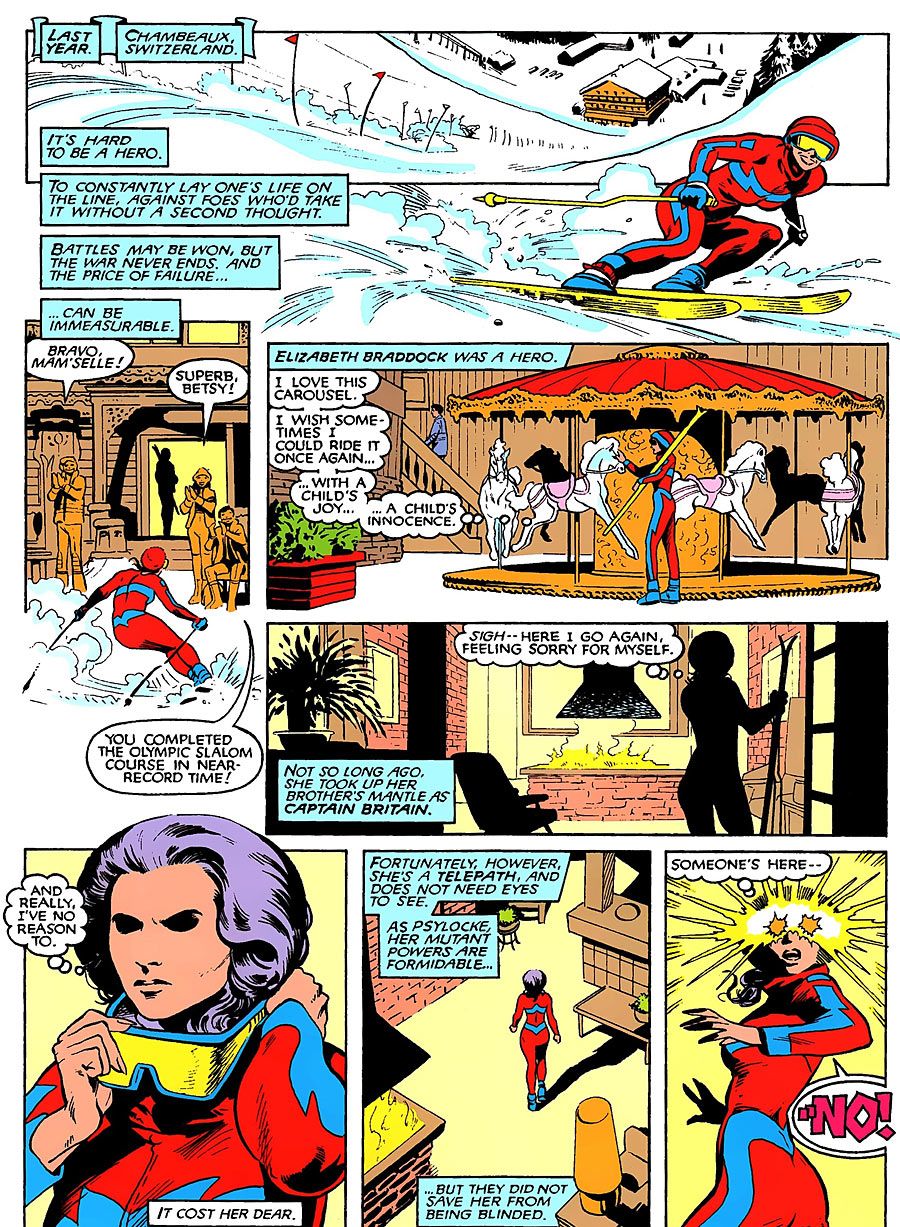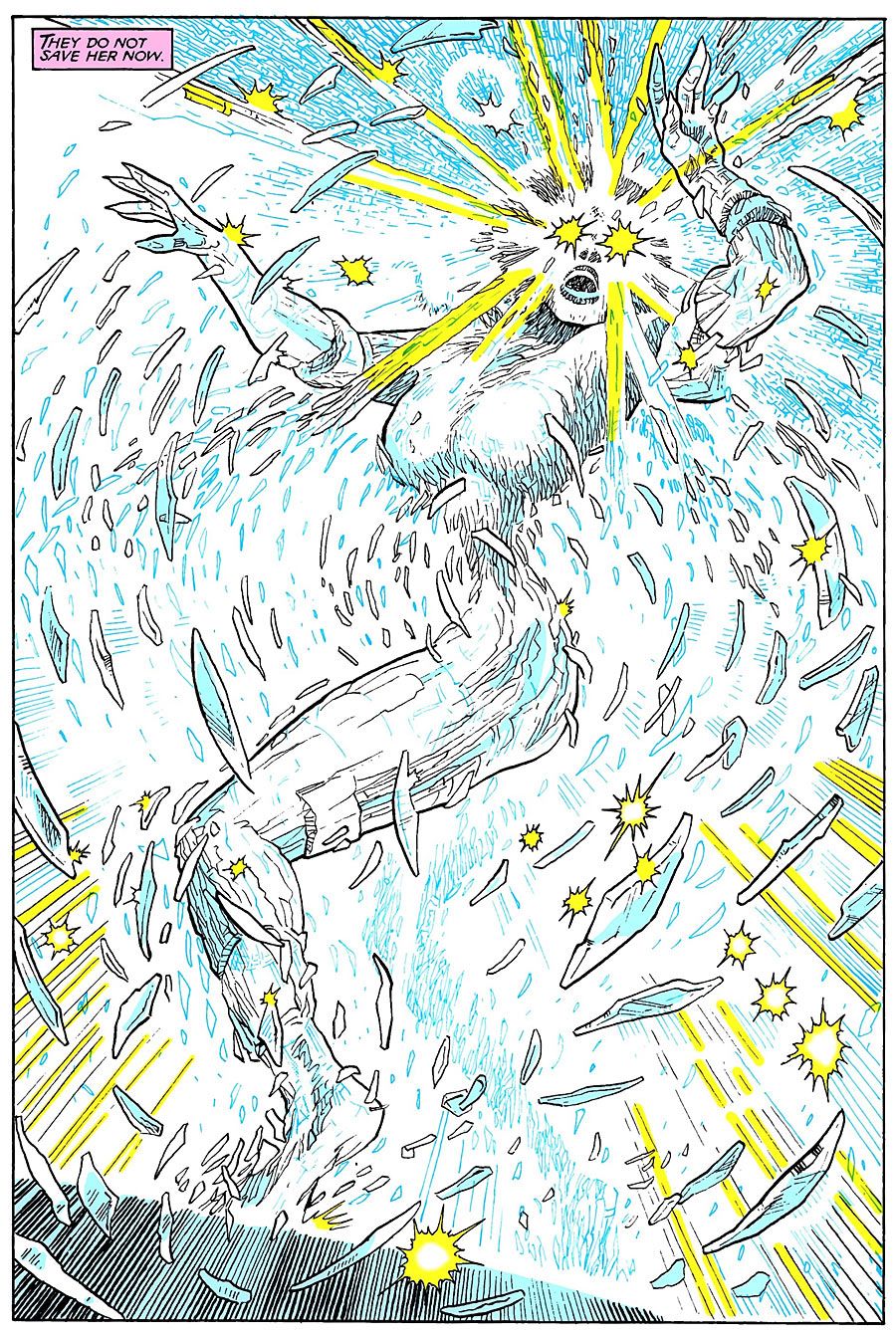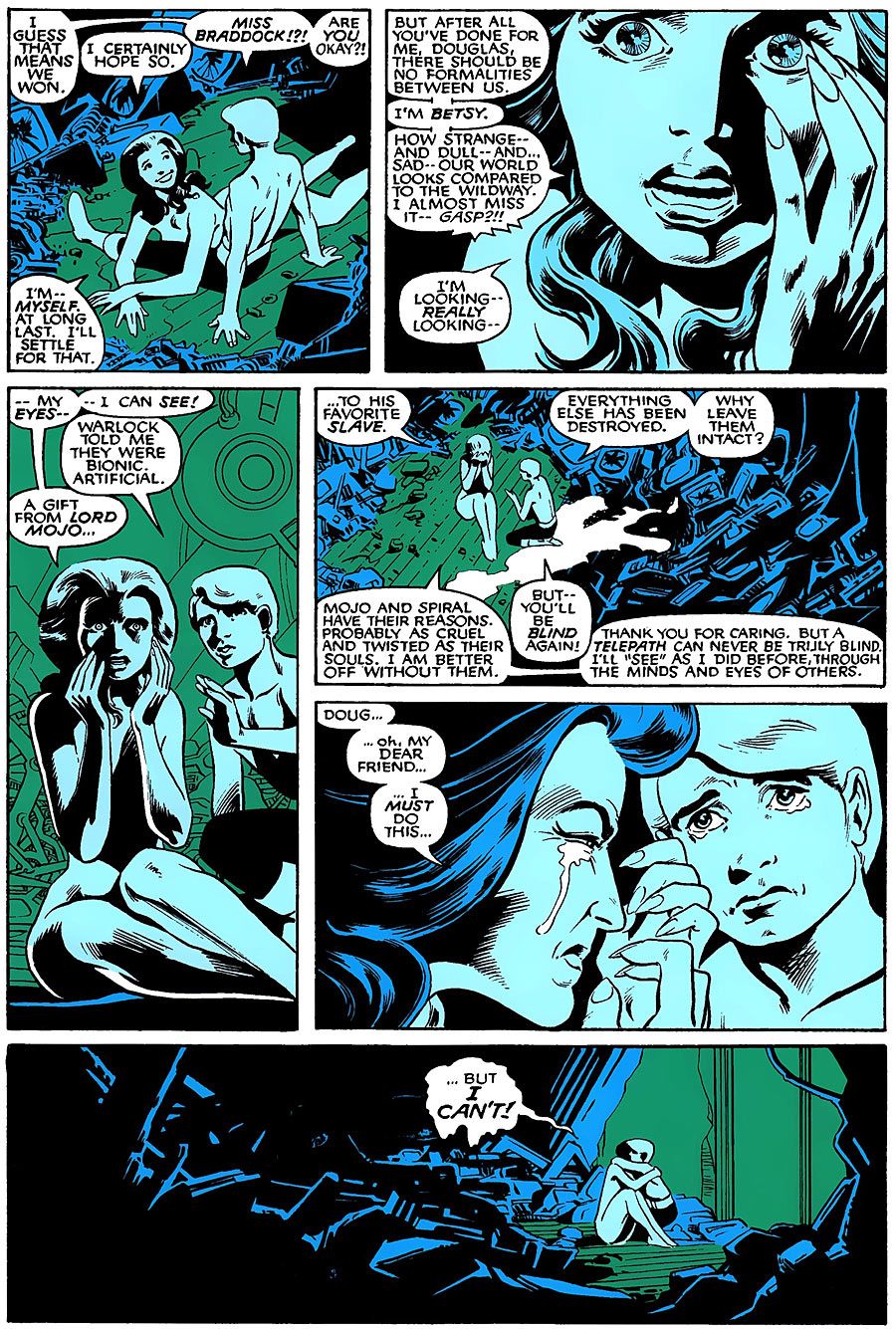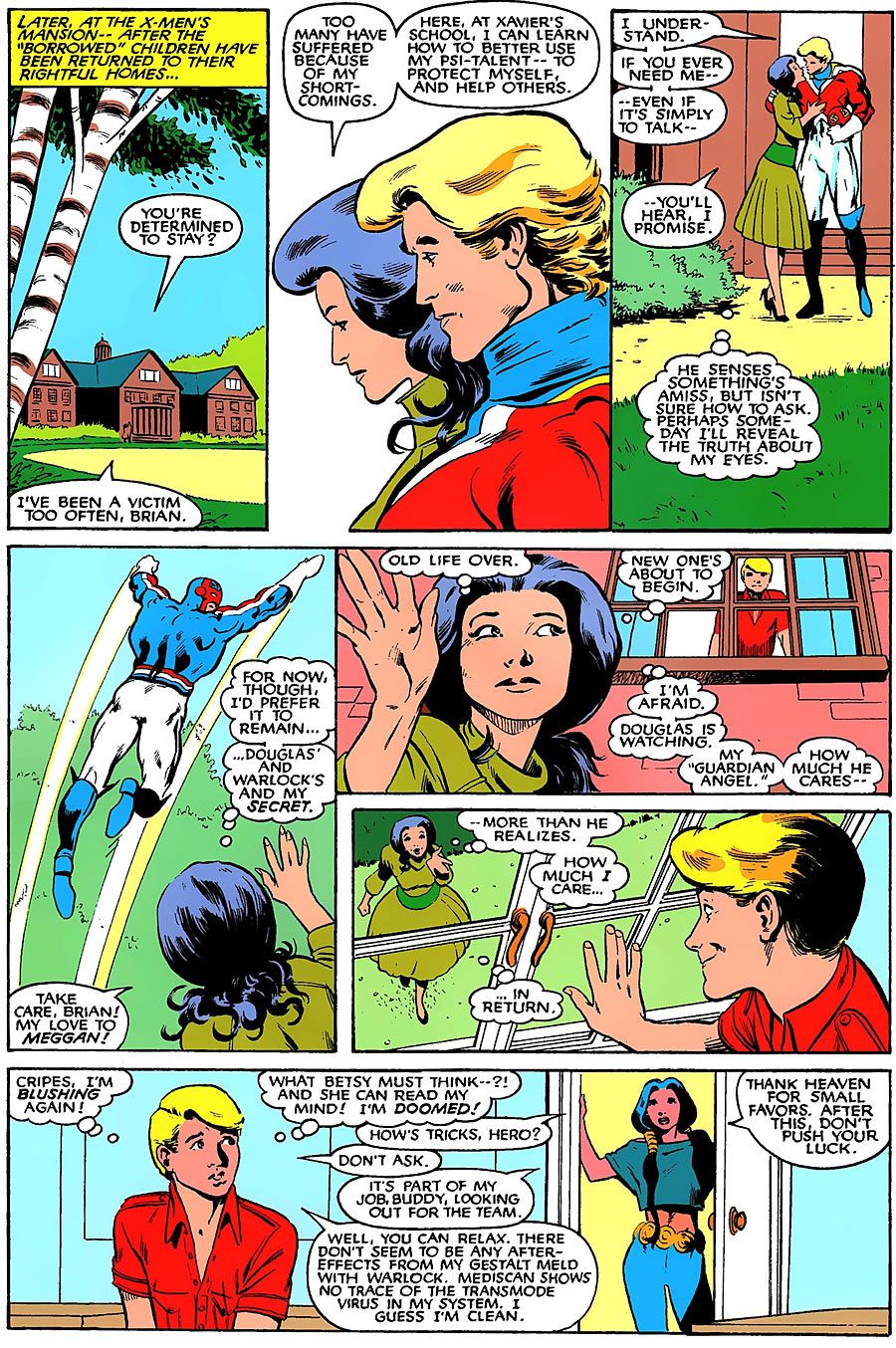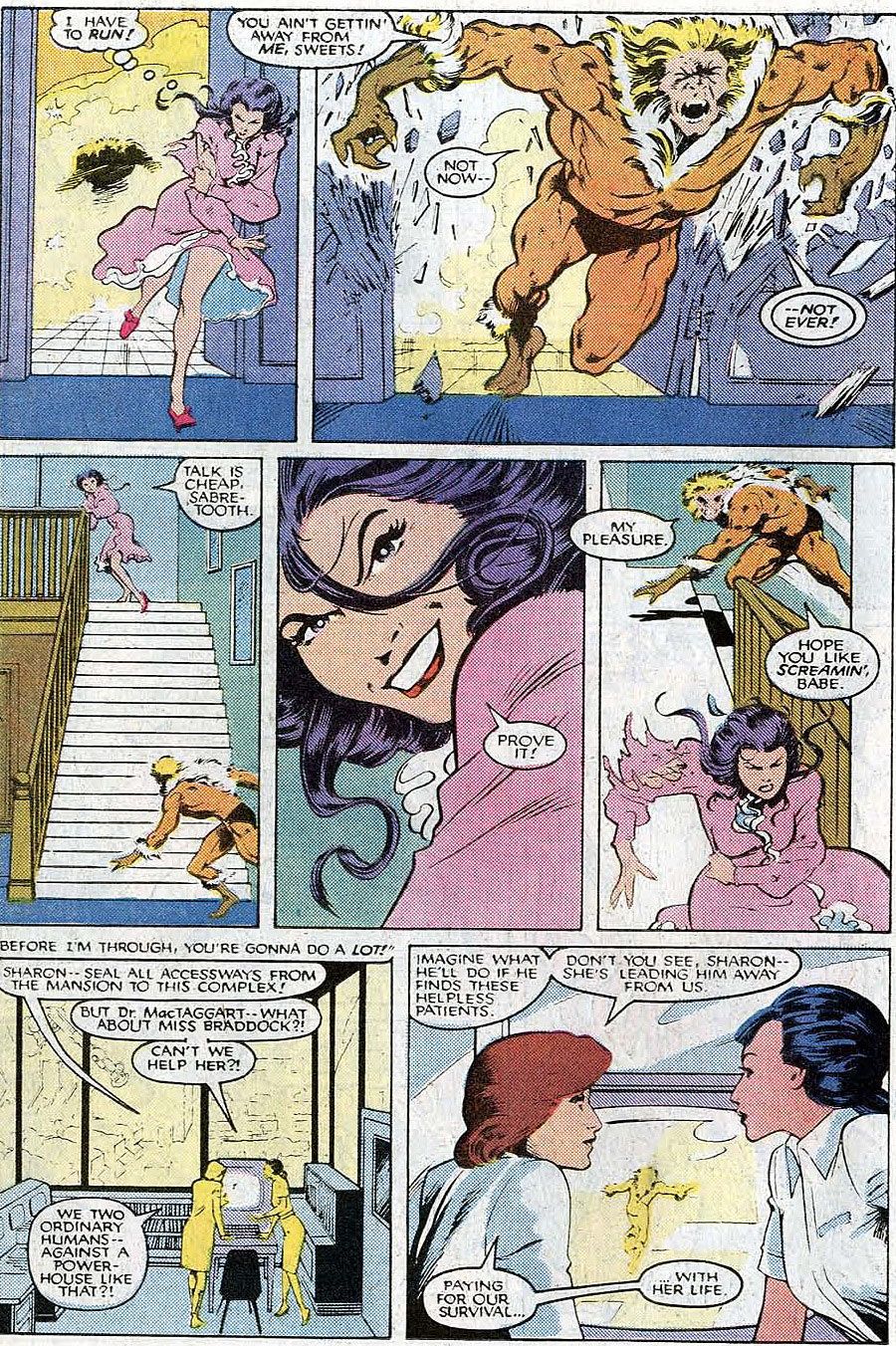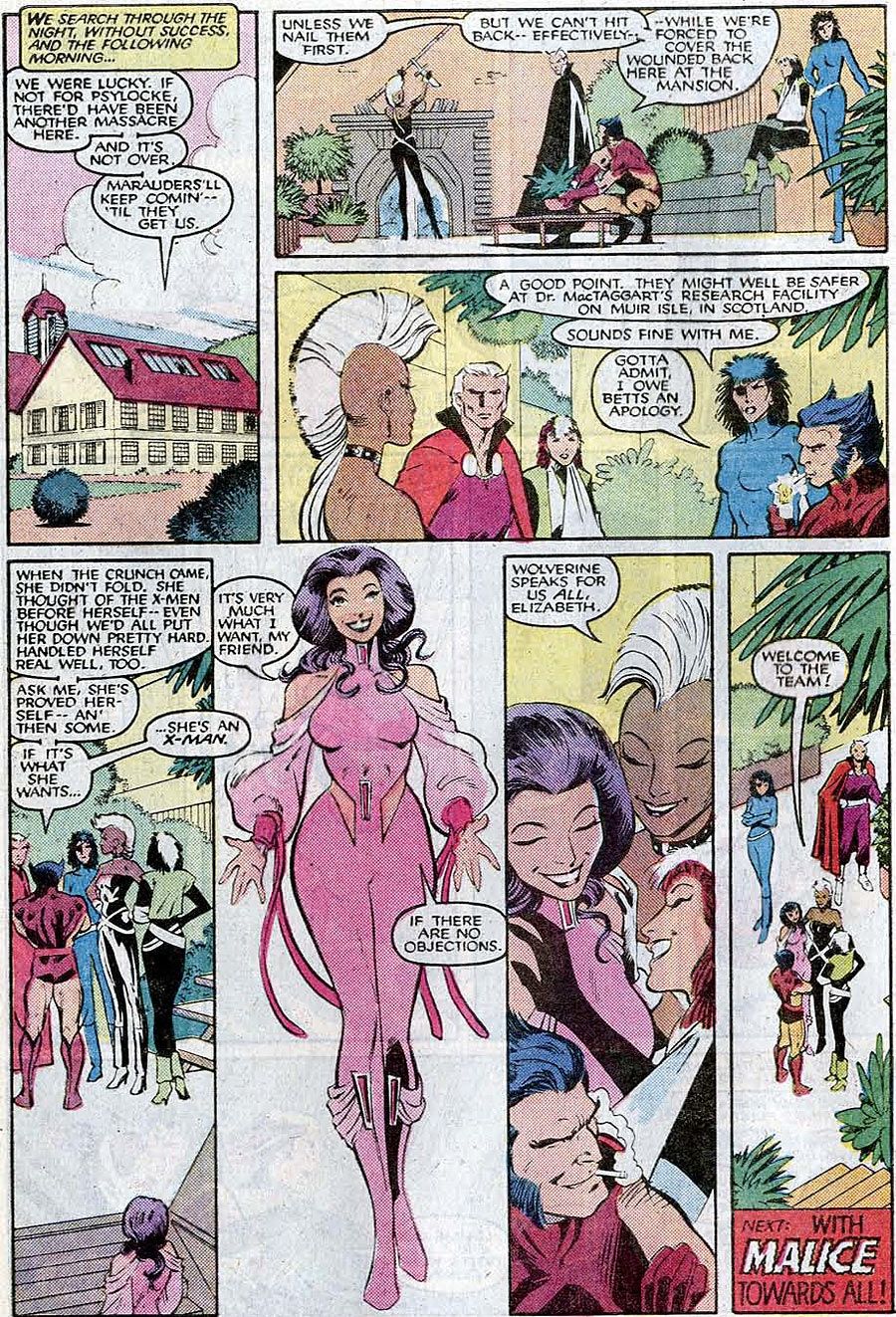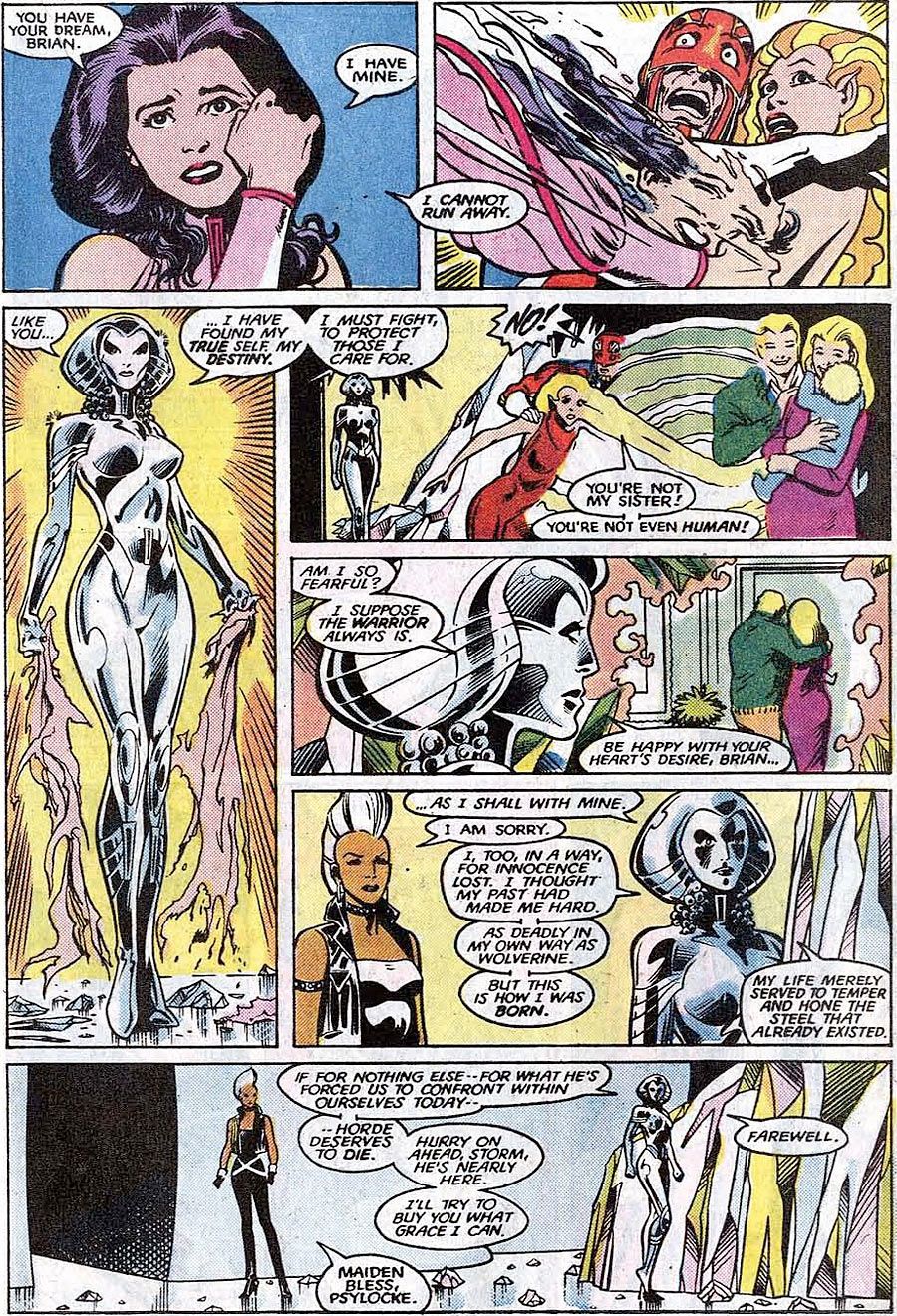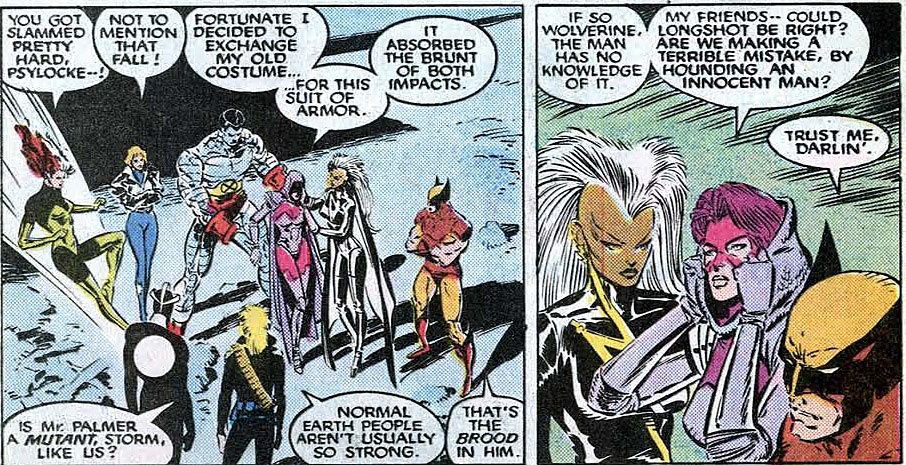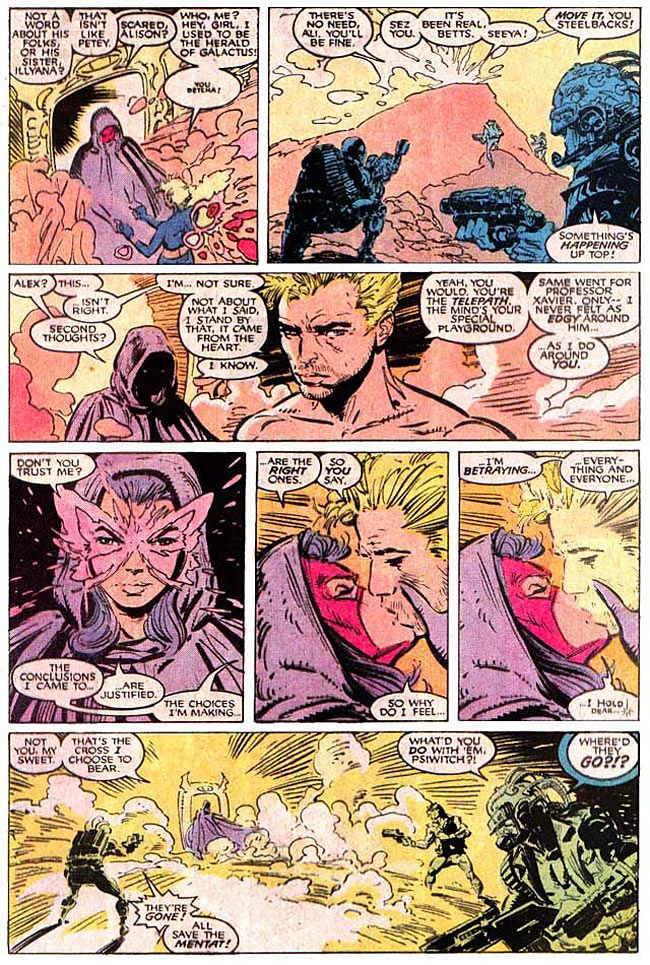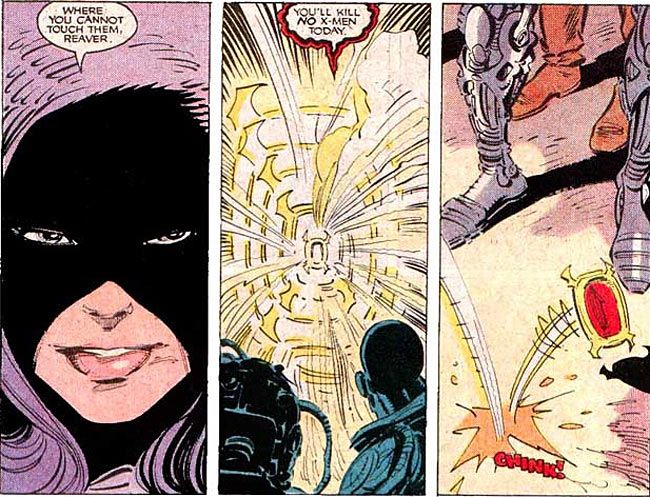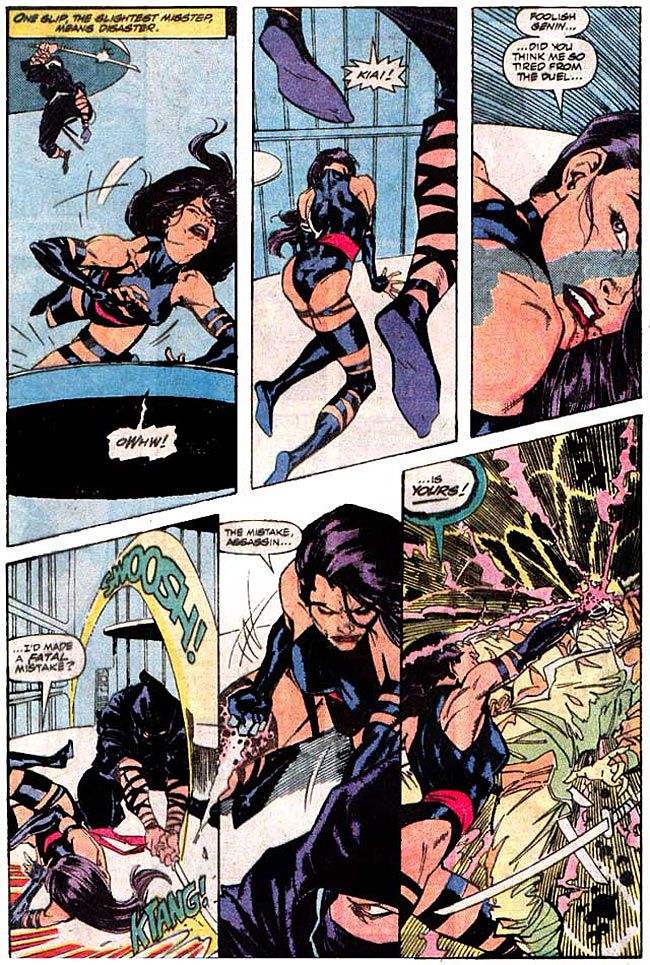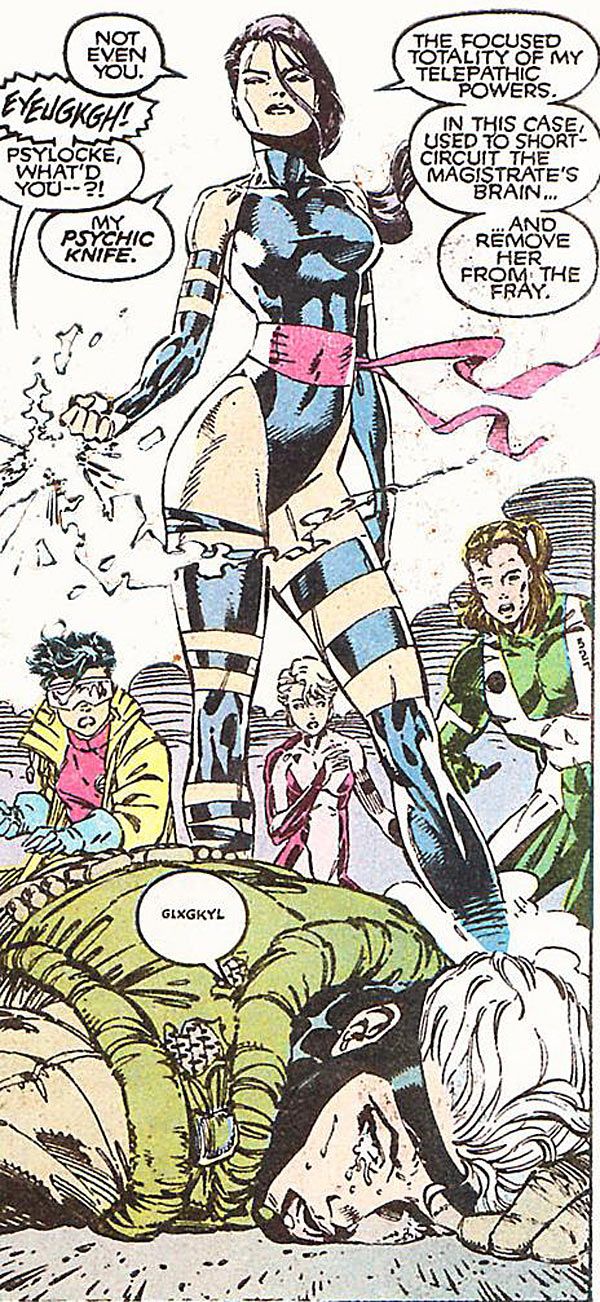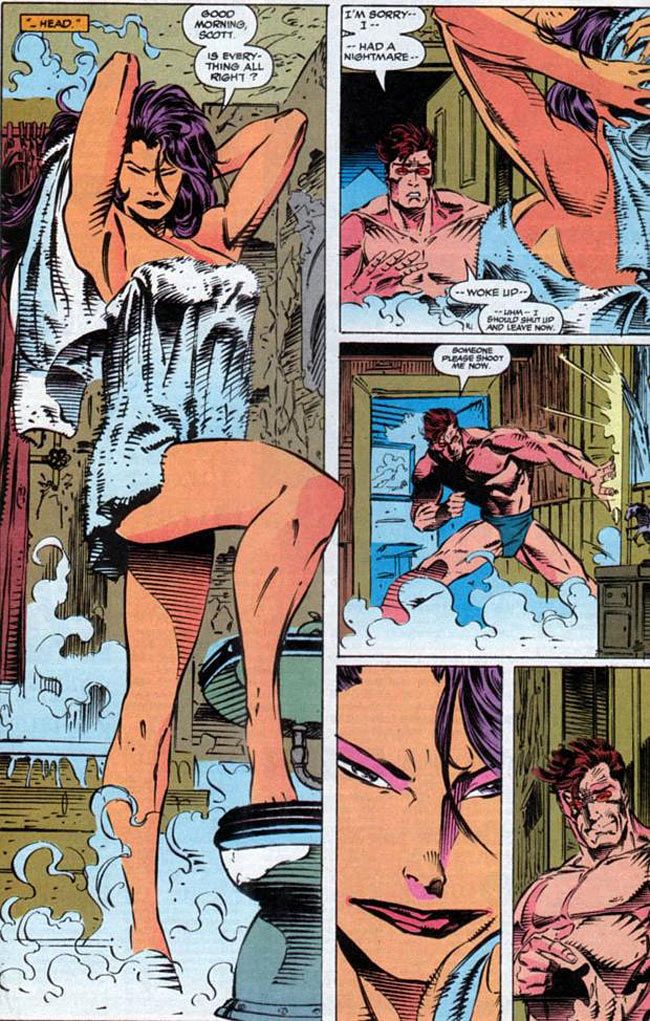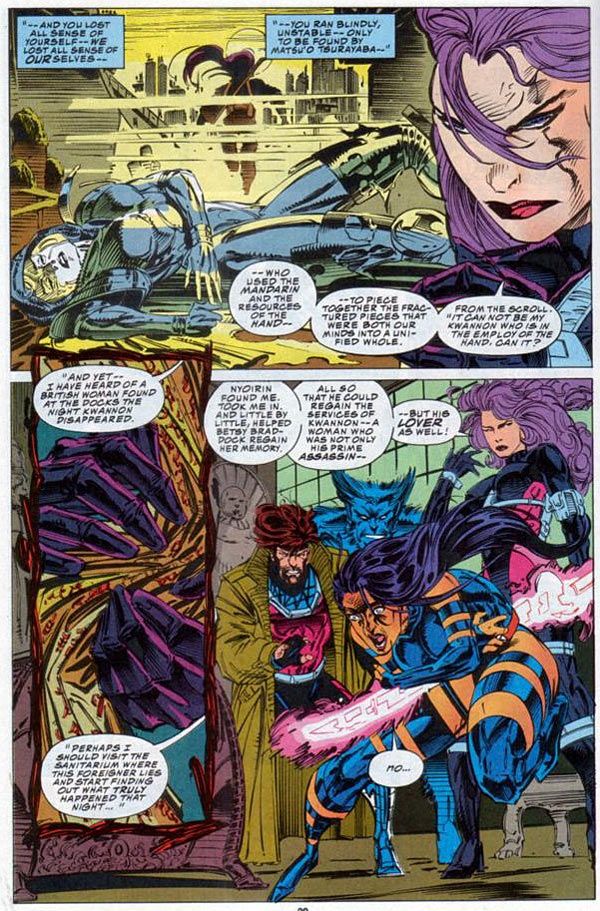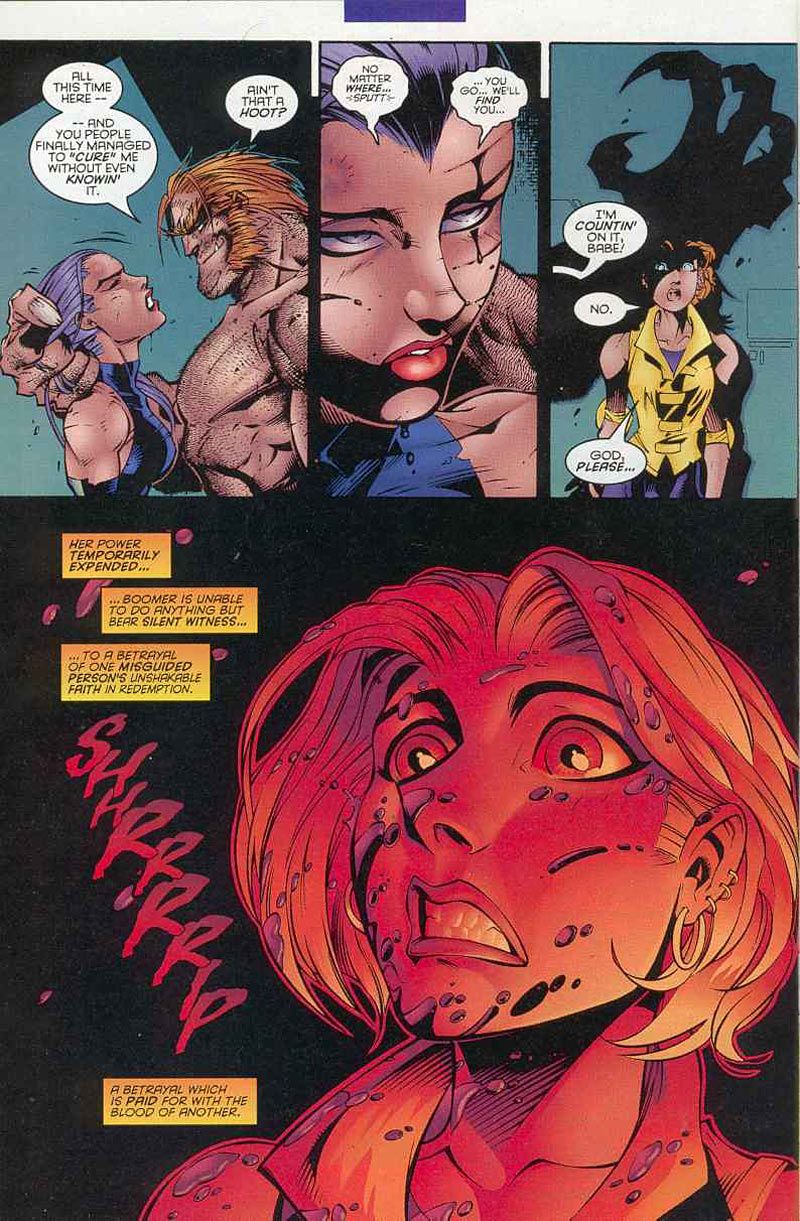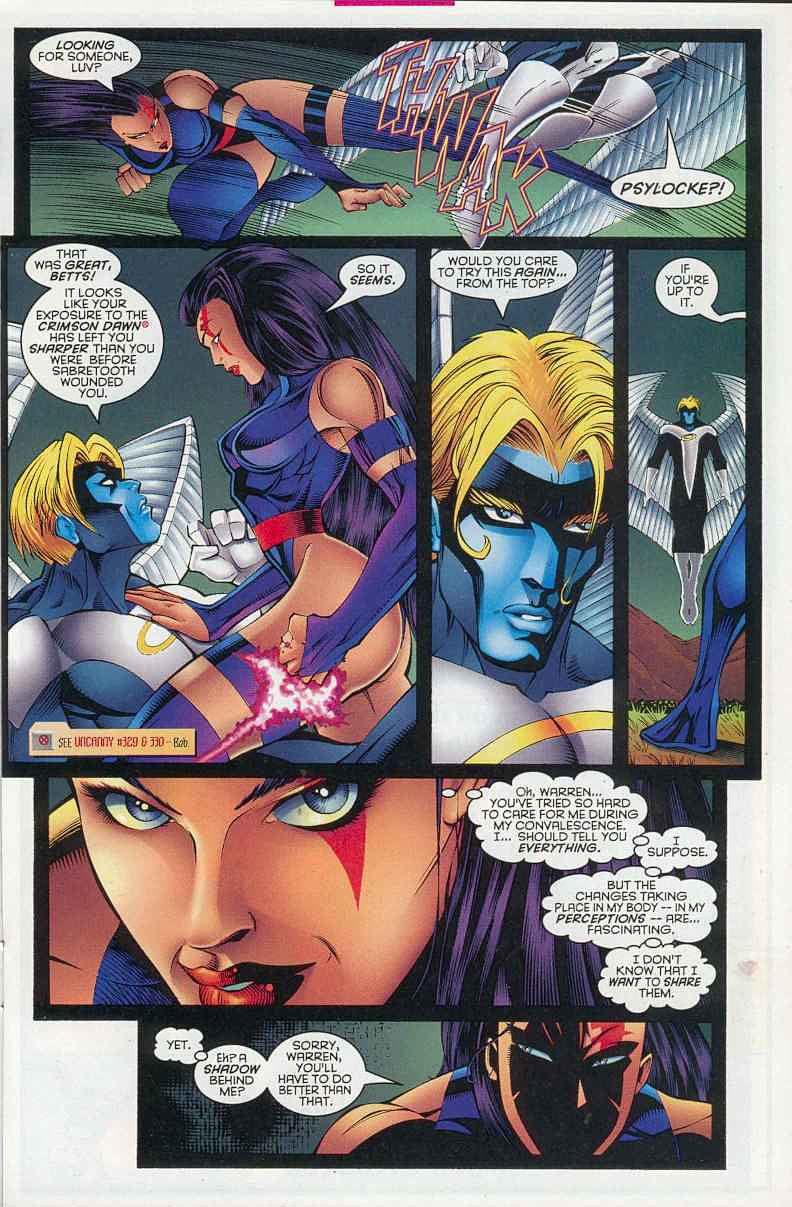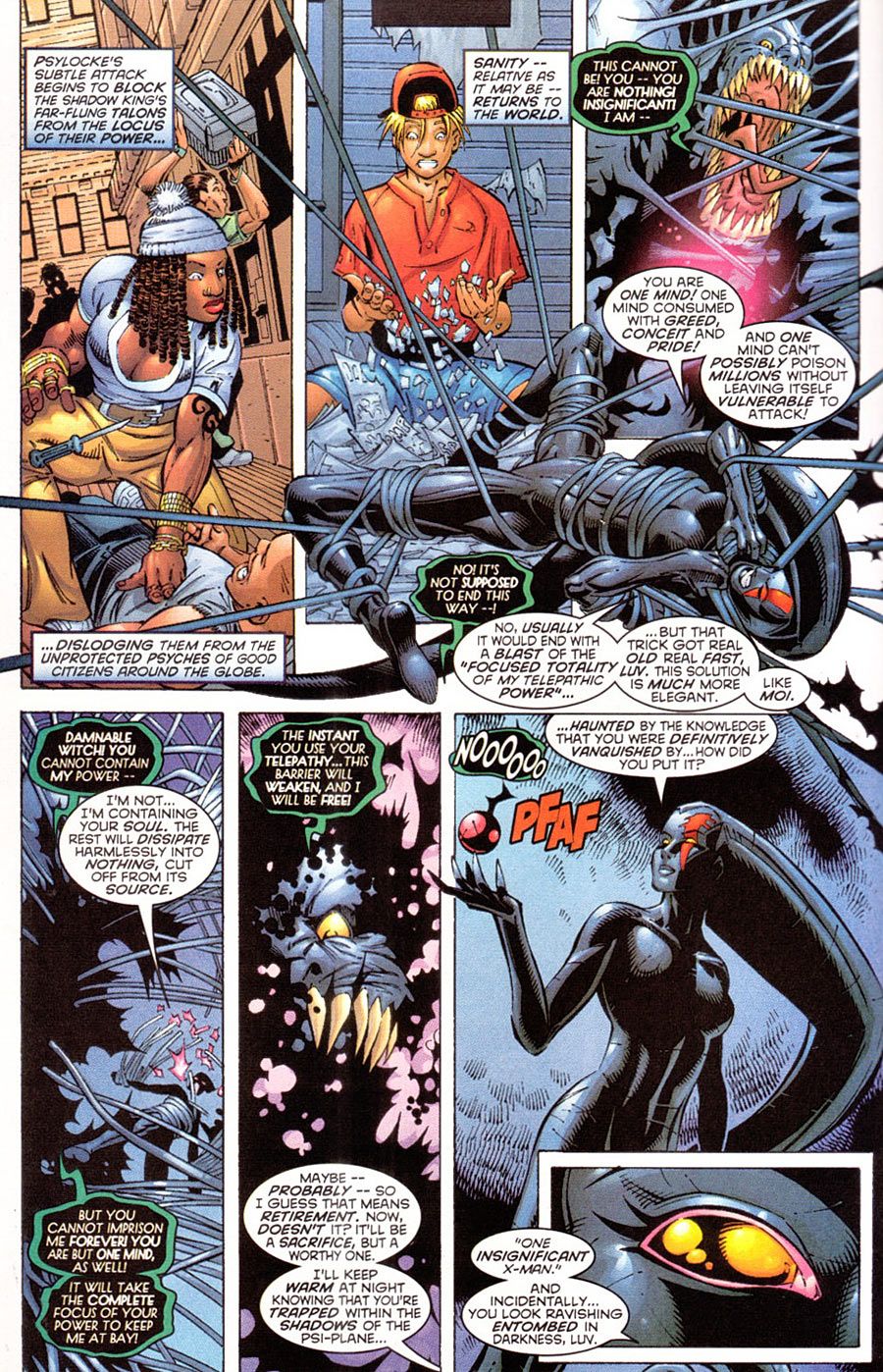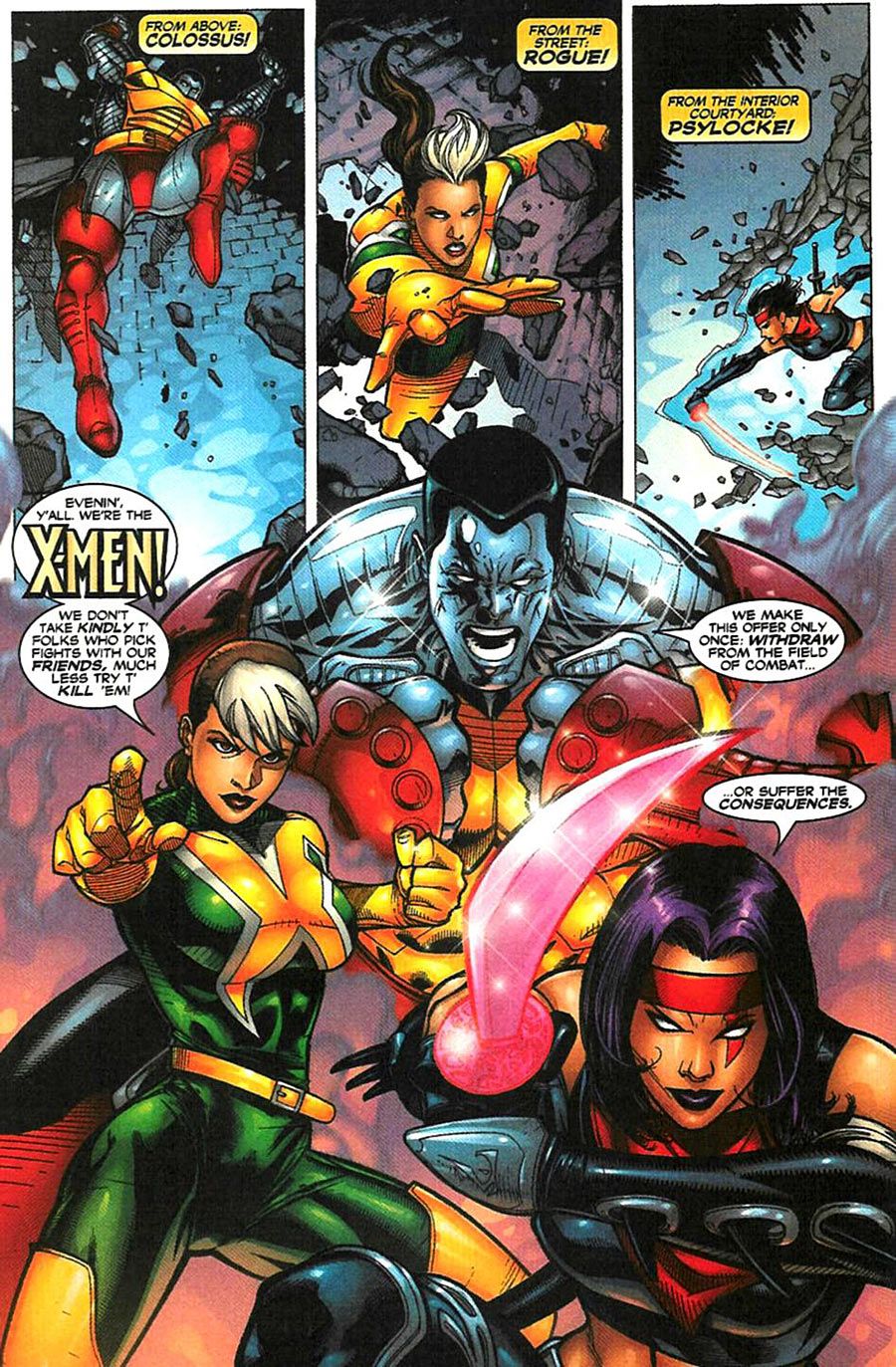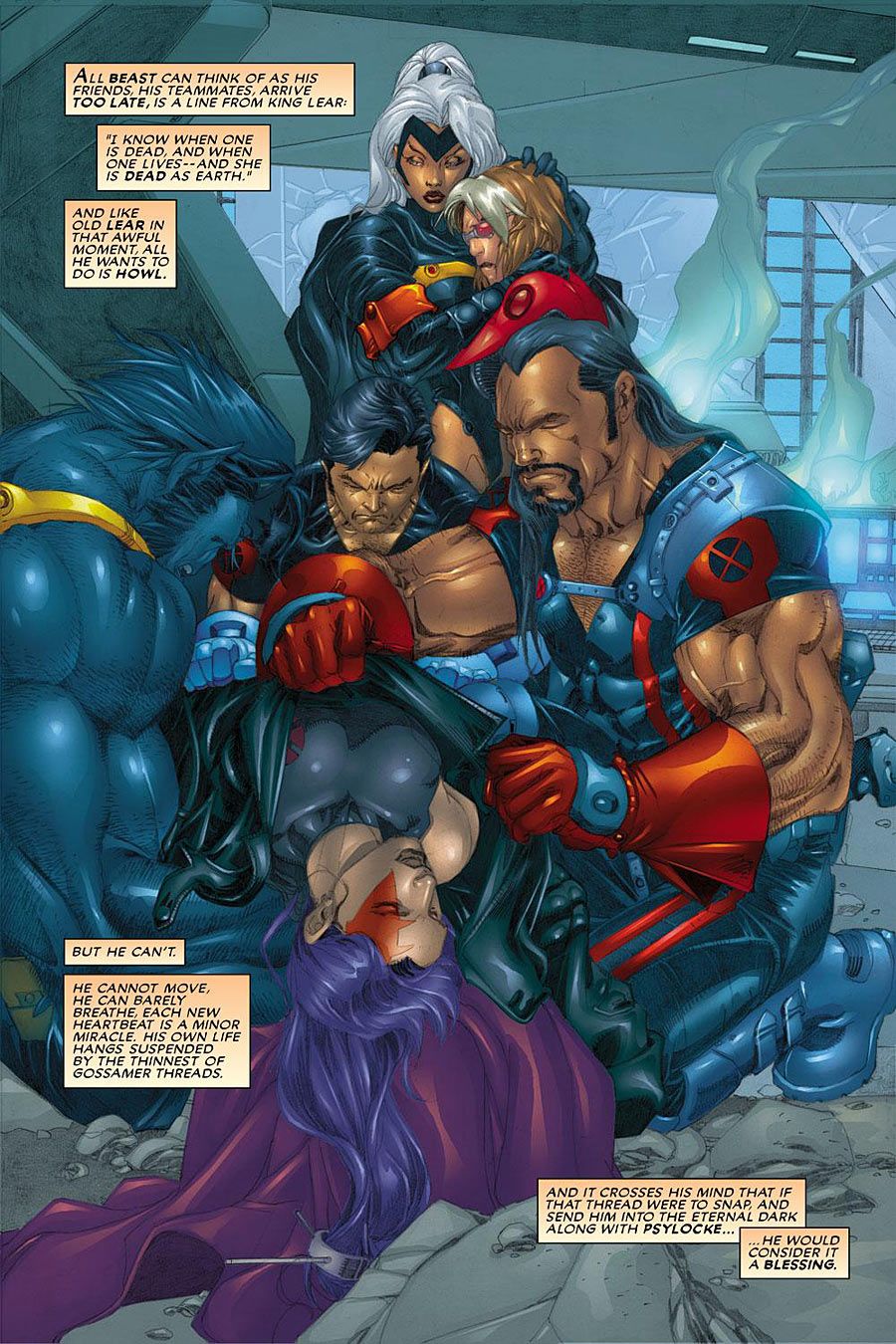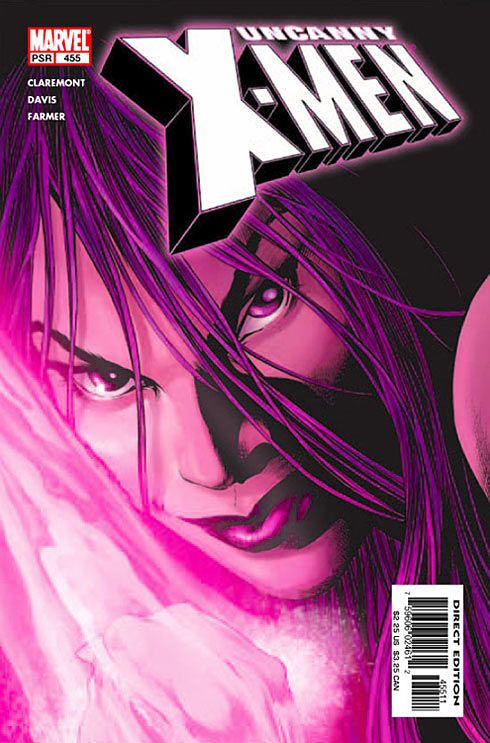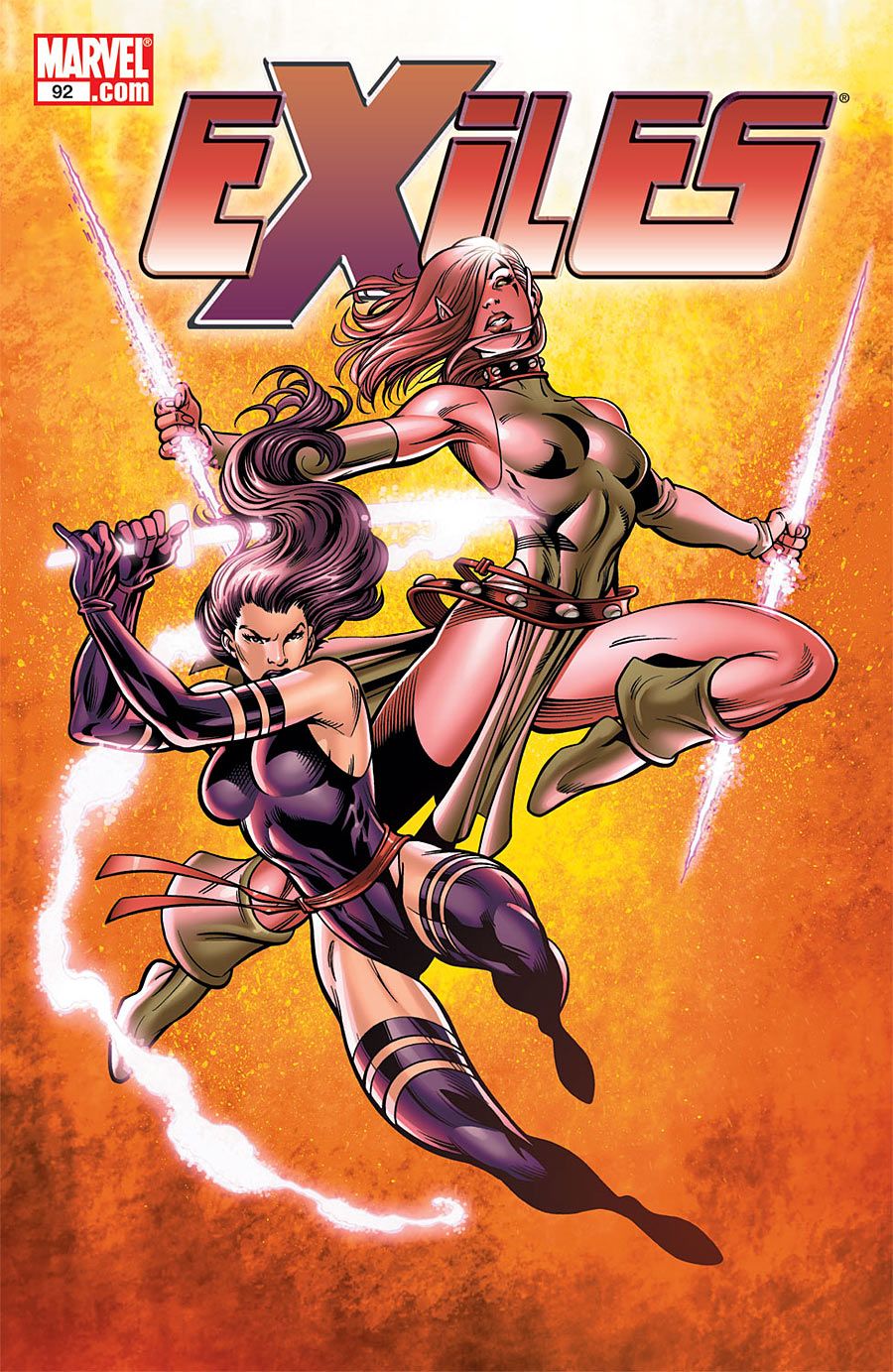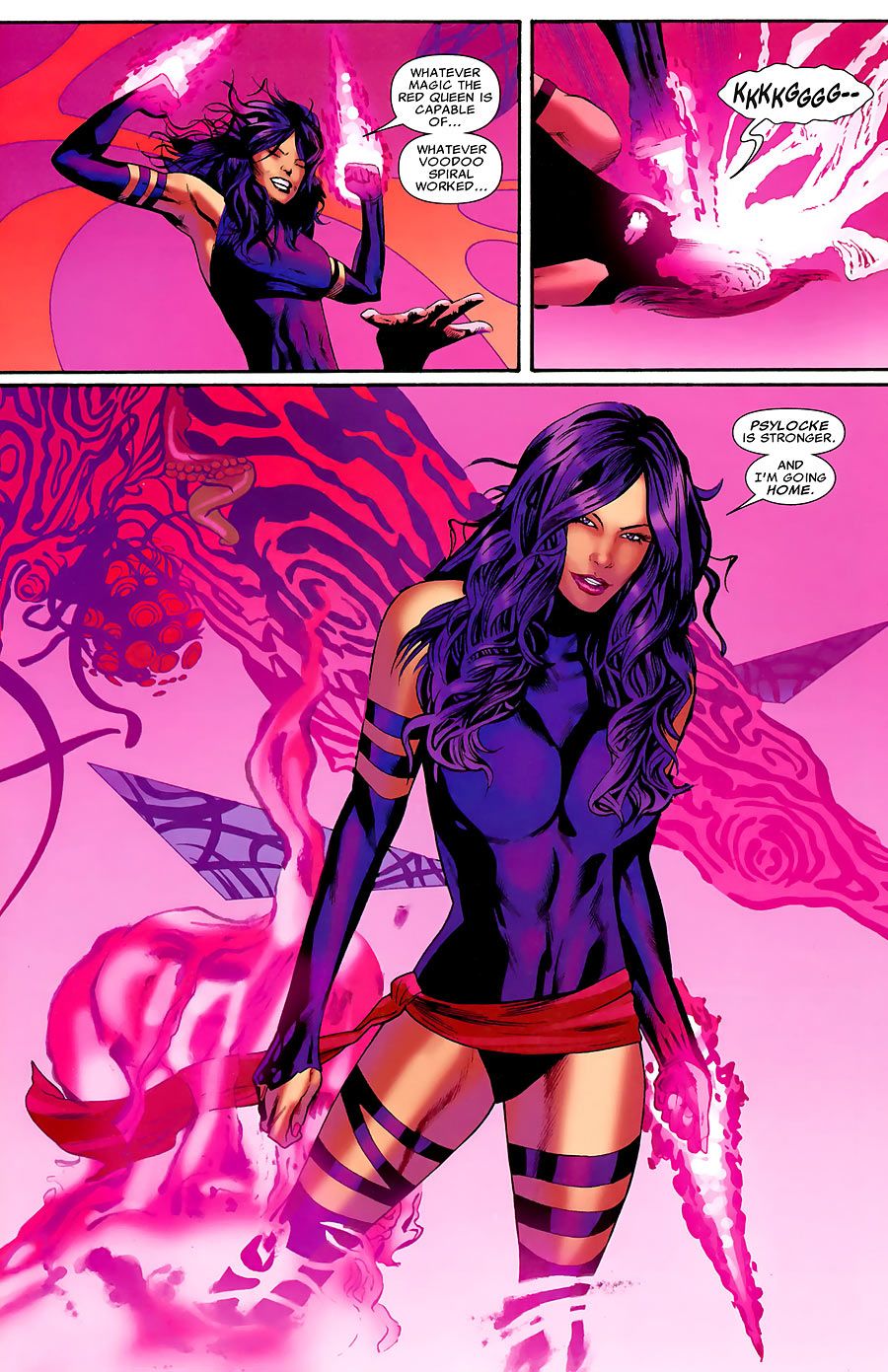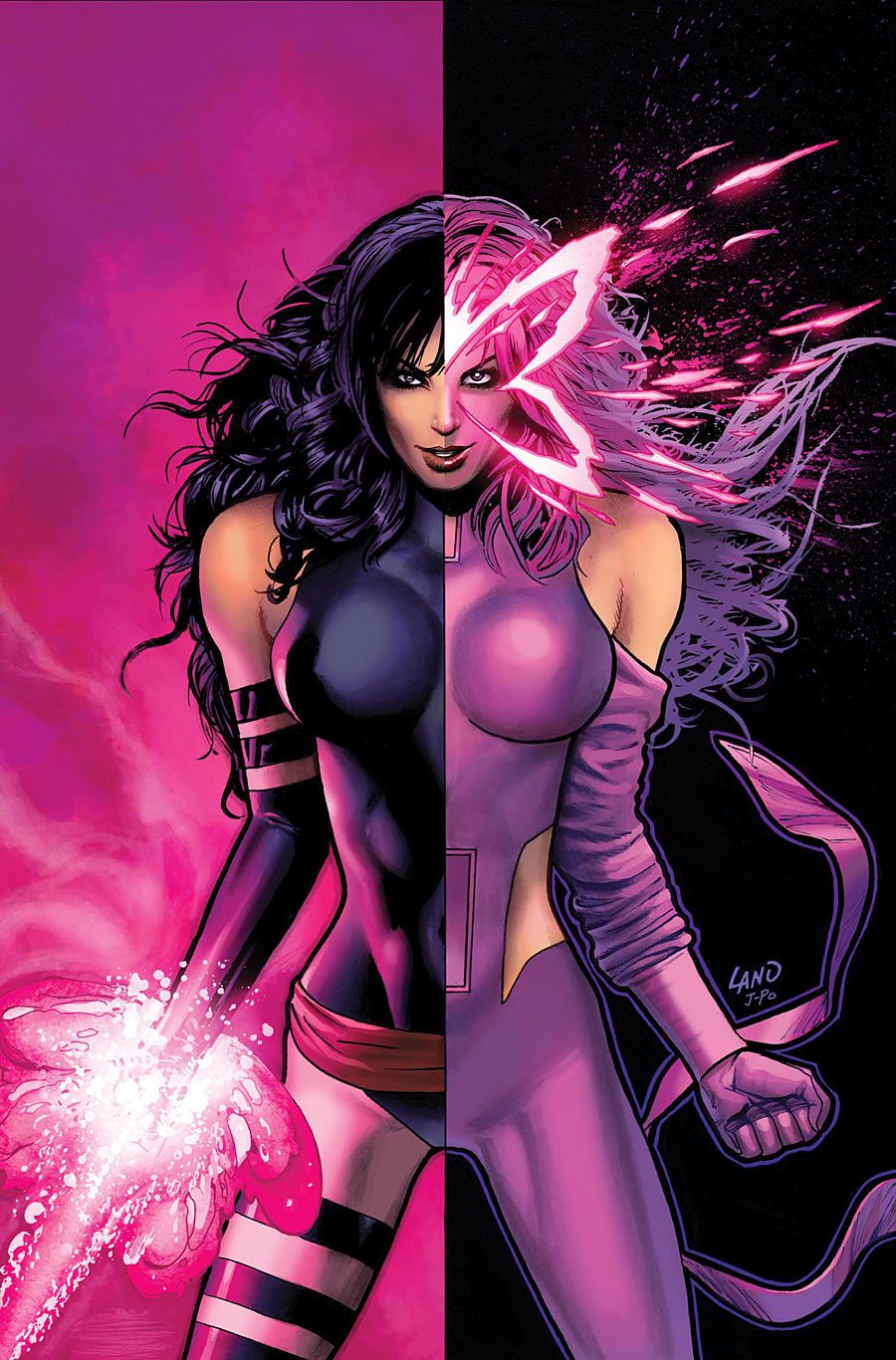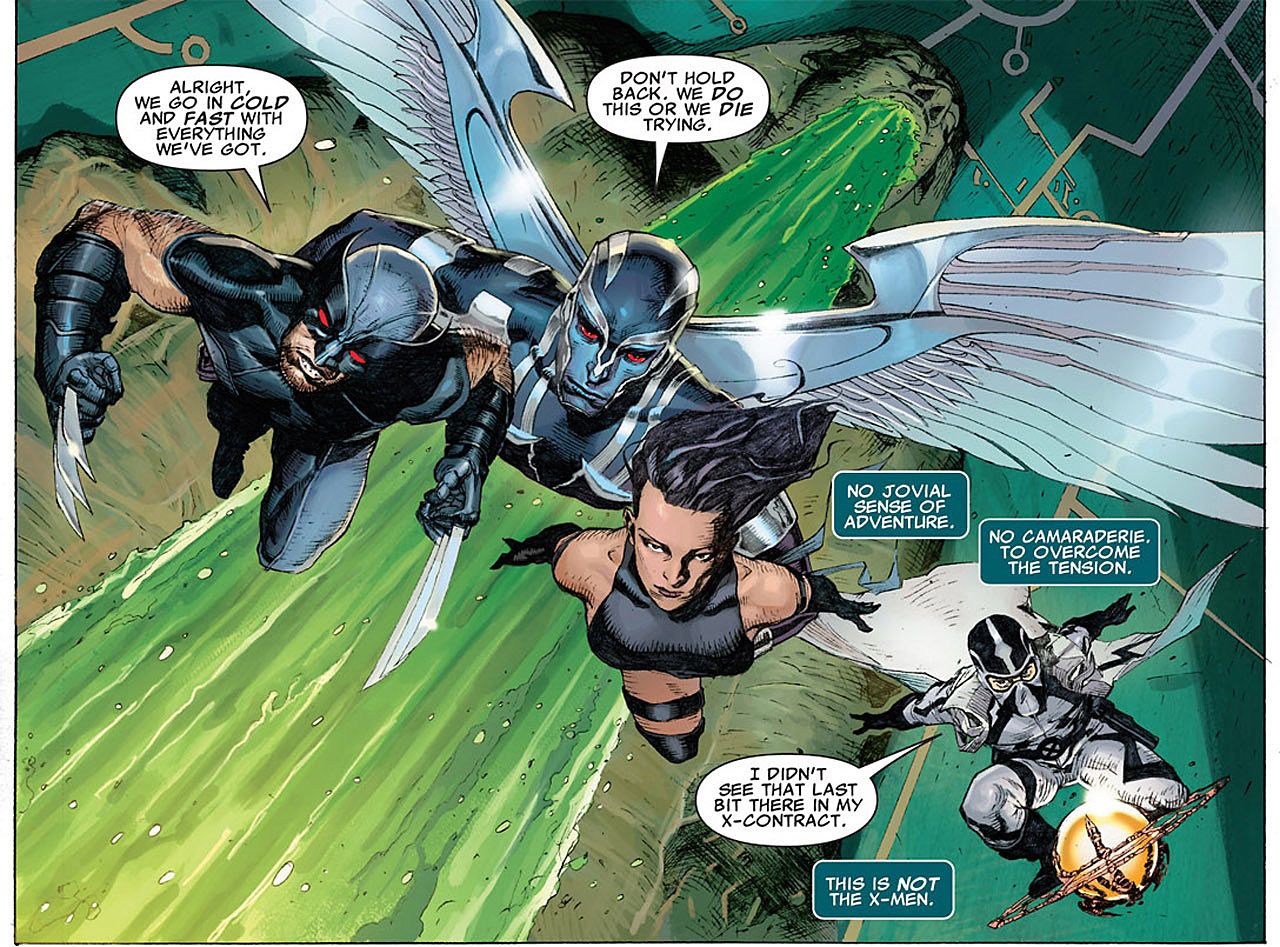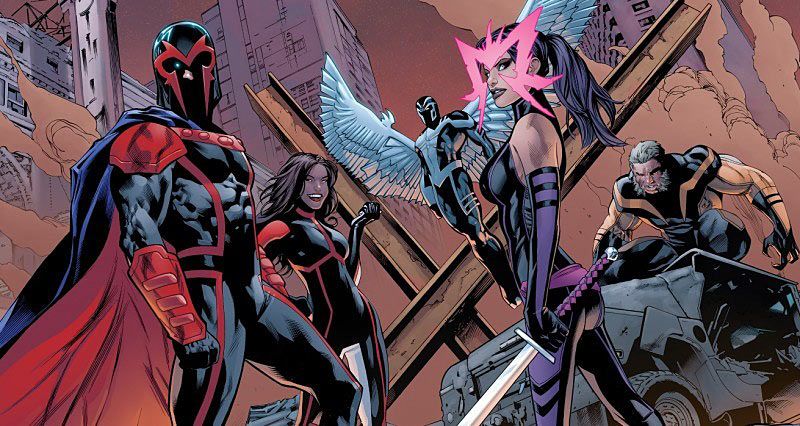Elizabeth "Betsy" Braddock, better known to X-Men fans as Psylocke, will play a major role in 20th Century Fox's "X-Men: Apocalypse." Debuting in 1976, the character had a complex and convoluted comic book career prior to joining the X-Men. Of course, once she joined up things didn't get any less complicated. From her early precognitive powers to her signature psychic katana, Psylocke has changed roles, powers and even swapped bodies. Through it all, she's been an enduring part of Marvel's X-Men titles over the last forty years.
Ahead of her role as one of Apocalypse's Horsemen in "X-Men: Apocalypse," CBR exhaustively chronicles Psylock's journey to stardom and tries to make sense of some of the more confusing parts of her story.
Betsy Braddock debuted in the "Captain Britain" #8, the twin sister of the eponymous character, AKA Brian Braddock, in a story by Chris Claremont, Herb Trimpe and Fred Kida. Betsy was already an accomplished pilot in her first appearance, and considering Claremont's mother was a pilot it's no surprise a number of different women in his comics have turned out to be charter pilots (including Madelyne Pryor a few years later in "Uncanny X-Men"). In that same first appearance, Betsy is mentally attacked by the dreaded Dr. Synne, who has a feud with Brian and Betsy's older brother, Jamie. Betsy is manipulated into almost killing Brian and Jamie by Synne in "Captain Britain" #10. Brian and Jamie take her to a clinic for people with "diseases of the mind," but it turns out that the clinic is secretly run by Synne himself! Luckily for Betsy, Claremont left the title with that issue and incoming writer Gary Friedrich drops the plot quickly, as Betsy recovers abruptly (much to Dr. Synne's consternation).
We next see Betsy in 1977's "Super Spider-Man and Captain Britain" #243 (by Jim Lawrence, Larry Lieber, Ron Wilson and Mike Esposito), where she is now inexplicably a fashion model! In that same issue, readers met a new Captain Britain villain, the assassin known as Slaymaster who would eventually play a major role in Psylocke's life.
Captain Britain kept appearing here and there in various Marvel UK publications. Dave Thorpe and Alan Davis gave Captain Britain a brand-new start in a Captain Britain feature in the weekly "Marvel Superheroes" in 1981, where Davis designed a brand-new costume for Brian. Alan Moore soon replaced Thorpe on the series and he and Davis brought the Captain Britain feature over to the monthly title, "Daredevils." In "Daredevils" #3, Moore and Davis brought Betsy back in a big way when she meets up with Brian for the first time in a number of years and has drastically changed. Her hair is now dyed purple!
While she is still working as a fashion model, it's actually a cover for Betsy's new job as part of S.T.R.I.K.E., Britain's answer to S.H.I.E.L.D. She works in the Psi-Ops division, making this the first time readers learned Betsy is a telepath and a precognitive. She came to Brian for help because members of her division are being hunted down and killed by Slaymaster. Brian ultimately saves Betsy from Slaymaster and Betsy remained a supporting character throughout Moore and Davis' famous run on the Captain Britain feature in "Daredevils" and later in "Mighty World of Marvel."
Betsy continued as a supporting cast member in the relaunched "Captain Britain" ongoing series by Jamie Delano and Alan Davis. In "Captain Britain" #5, a double of Captain Britain attacks Betsy and Brian at Braddock Manor. The double is seemingly defeated, but in reality it was the real Captain Britain who was taken away. The double attacked Betsy, leading her to eventually kill him. Betsy then accepted the protection of the Resources Control Executive (RCX), the organization that took over from the now-defunct S.T.R.I.K.E., and the group took up residence at Braddock Manor. Brian did not like this and cut out for a while. When he returned in "Captain Britain" #12, he discovered that the RCX had made Betsy the new Captain Britain in his place! The Captain Britain suit gave Betsy power on top of her telepathy, but it turned out not to be enough to stop Slaymaster when he showed up in "Captain Britain" #13 (written and drawn by Alan Davis) as the villain blinded Betsy. Brian manages to save her and seemingly kill Slaymaster. The next issue was the final one of the "Captain Britain" ongoing series, and readers got to check in with Betsy to see that she was adjusting well to being blind, using her telepathic powers to see. She also specifically rejected an offer from RCX to give her cybernetic replacement eyes.
Meanwhile, Chris Claremont had been working on Alan Davis, trying to convince him to come over and draw X-Men comics. While still doing "Captain Britain," Davis had already begun working on the American side of things for DC Comics on "Batman and the Outsiders" in 1984 and followed "Outsiders" writer Mike W. Barr to "Detective Comics" in 1986. Davis, though, was having issues with DC, so he agreed to work out a deal with Marvel through Claremont where he would bring Captain Britain over to the American Marvel offices. This would eventually become the X-Men spinoff, "Excalibur." While he was waiting for "Excalibur" to get ready to begin, however, he found other work at Marvel, drawing two issues of "Uncanny X-Men" and both the 1987 "Uncanny X-Men Annual," as well as the 1986 "New Mutants Annual." His first assignment for Marvel with Claremont was "New Mutants Annual "#2. And guess who came along for the ride with Alan Davis? Betsy Braddock herself!
"New Mutants Annual" #2 sees Betsy kidnapped by Spiral on the orders of the inter-dimensional creep, Mojo. As she is abducted, we learn her codename, Psylocke, for the very first time. The New Mutants rescue Betsy, with Doug Ramsey in particular getting close to her. Mojo gave her cybernetic eyes courtesy of his "Body Shop." Her first impulse was to tear them out of her skull, but could not bring herself to give up her eyesight once again. Brian visited her at Xavier's School for Gifted Youngsters, where Betsy decided to stay for a while.
Her timing wasn't exactly great, as she got there just in time for the Mutant Massacre to take place. Davis drew her second appearance with the X-Men in "Uncanny X-Men" #213, where she uses Cerebro (as the only telepath on the team at the time) when Sabretooth attacks. Psylocke proves herself to everyone by managing to stay alive against Sabretooth until her teammates showed up to help and then coming up with the idea of using an attack by Wolverine against Sabretooth to probe Sabretooth's distracted mind to gain information about the evil Marauders, the mutant hunters responsible for the Mutant Massacre. At the end of the issue, Psylocke become an official member of the X-Men.
While a member of the team, Psylocke had issues relating to her teammates and in the 1987 "X-Men Annual" #11, drawn by Alan Davis and Paul Neary, we see each of the X-Men's inner-most weakness. Psylocke's self-doubt centered around her seeming lack of emotions, making her feel like she was more robot than human. Soon afterward, Psylocke and the rest of the X-Men seemingly sacrificed themselves to stop the evil Adversary. Instead, the Omniversal Guardian Roma (a character from the pages of "Captain Britain") chose to resurrect the X-Men. The team decided to move to Australia and fight crime from a hidden base on the island nation (with a mysterious Aboriginal mutant known as Gateway supplying them teleportation to wherever they need to go to fight the bad guys). In "Uncanny X-Men" #232 (by Chris Claremont, Marc Silvestri and Dan Green), Psylocke, wary of how unprotected she was during battle, decided to adopt a new armored costume. The X-Men's stint in Australia was relatively short-lived, however, and by "Uncanny X-Men" #251 (by Claremont, Silvestri and Green), the team was down to just four members -- Havok, Colossus, Dazzler and Psylocke. When Roma brought the team back to life, she also provided them an option for a fresh start called the Siege Perilous. When Psylocke's rarely used precognition powers showed her the leftovers of the team being killed by the Reavers, she manipulated her three teammates' to enter the Siege Perilous and go their separate ways. Her actions likely saved her life and the lives of her friends.
In "Uncanny X-Men" #256 (by Chris Claremont, Jim Lee and Scott Williams), Psylocke visits Mojo's Body Shop and is turned into an Asian ninja, brainwashed into working for the Mandarin, even going by the name "Lady Mandarin" for a time before her former teammate, Wolverine, liberated her from the brainwashing. She joined up with Wolverine and Wolverine's traveling companion of the time, Jubilee, as they tried to put the X-Men back together. Claremont intended Betsy's transformation into an Asian ninja to be temporary, but it was so well-received (likely owing a great deal to how Jim Lee drew her in the storyline) that it became her new status quo. At this same time, she also began using her telepathic powers in a new way. She basically "weaponized" her telepathy, creating a psychic energy knife. In Uncanny X-Men #271 (by Claremont, Lee and Williams), she first described the knife as the "focused totality of my telepathic powers," a phrase she used often enough that it soon became one of the better known cliches of the era.
The X-Men got back together and merged with X-Factor, which was made up of the original five members of the X-Men (Cyclops, Jean Grey, Beast, Archangel and Iceman). The large group of mutants decided to split into two "squads," a Gold Team and a Blue Team. Psylocke was on the Blue Team, along with most of the other most popular mutants of the era (Wolverine, Gambit, Rogue, Cyclops and Beast, with Jubilee often along for the ride). Around this same time, she and Cyclops began a long period of flirtation. If Jean Grey were to do her own Lemonade album, Psylocke would likely be considered "Betsy with the good, purple hair." The plot was always just meant to be a flirtation and nothing else, according to Fabian Nicieza, the writer of the "X-Men" ongoing series, which starred the Blue Squad.
Soon afterward, Psylocke met Revanche, who showed up in Betsy's original body! You see, Nicieza had missed the issue of "Uncanny X-Men" where Claremont had established that Betsy's body was altered into being Asian, so Nicieza decided to reveal that her original body was switched with the body of an Asian ninja mutant named Kwannon, who was now in Betsy's old body and calling herself Revanche. When he was informed of his mistake, he then revealed that they basically were spliced together, so there was no "original" body involved anymore. Kwannon soon developed the Legacy Virus and eventually died of it many years later.
Psylocke was now solidified as a stalwart member of the X-Men and the writer of the other ongoing X-Men title, "Uncanny X-Men," Scott Lobdell, began to have Betsy enter into a romance with a member of the Gold Squad, Warren Worthington III, AKA Archangel. Warren and Betsy both came from wealthy families and they saw each other as kindred spirits. Tragedy struck, however, when Psylocke was once again attacked in the X-Mansion by Sabretooth. This time, however, she did not get away so lucky. An escaped Sabretooth (who had been kept prisoner in the Mansion) gutted Psylocke in "Uncanny X-Men" #328 (by Lobdell, Joe Madureira and Tim Townsend), nearly killing her. Wolverine and Archangel saved her by exposing her to an ancient mythical object known as the Crimson Dawn. It revived Betsy, but gave her a strange red tattoo on her face and new, mysterious abilities.
A short time later, incoming writers Joe Kelly and Stephen T. Seagle planned on killing Psylocke off in a crossover involving the Shadow King called the Psi-War. Instead, in "X-Men" #78 (by Joe Kelly, German Garcia and Art Thibert), Psylocke sacrificed her telepathic powers to trap the Shadow King within her mind.
Psylocke was in limbo for a year or so before Chris Claremont returned to the X-titles and he quickly brought Psylocke back, revealing that she and Jean Grey had somehow traded powers, and now Jean Grey only had telepathic abilities while Betsy had telekinesis. She then used her telekinetic abilities to create a new psychic knife that was now basically a physical blade. Claremont also had Psylocke and Archangel drift apart, with Psylocke ultimately ending up with her new teammate, Neal Shaara, the new Thunderbird. Psylocke and Thunderbird were part of a group of X-Men who went on a special mission to hunt down the mysterious diaries of the powerful precog, Destiny. While with this team of X-Men (who became known as the X-Treme X-Men), Psylocke was killed by a new villain known as Vargas in "X-Treme X-Men" #4 (by Claremont and Salvador Larocca). Originally, Claremont only meant to kill her off temporarily, so that he could bring her back and sort of simplify the character (excise the Crimson Dawn stuff, explain her powers, etc.), but he ran afoul of a temporary freeze at Marvel on bringing characters back from the dead. It would not be for four more years, until Claremont returned to "Uncanny X-Men" alongside Alan Davis (with Mark Farmer on inks) that he and Davis were able to bring Psylocke back to life.
Claremont's third stint on "Uncanny X-Men" turned out to be a short one, as well, and in 2008, he took Psylocke with him as she became a member of the interdimensional superhero group known as the Exiles (her path crossed once again with Sabretooth's, only now he was an alternate universe Sabretooth who was a hero!). She continued with the team as it launched into a new series called "New Exiles," where the cast concentrated on alternate versions of characters that Claremont himself had created (like Psylocke, Kitty Pryde, Rogue and Sabretooth). When that series ended, the implication was that she was still with the Exiles, doing their thing, jumping around the Multiverse making things right.
In "Uncanny X-Men" #508 (by Matt Fraction and Greg Land), however, the evil group the Sisterhood, led by the Red Queen, plucked Psylocke out of the other dimensions and trapped her in her original Betsy Braddock body, which the Sisterhood had revived and put under their control to serve the Sisterhood. In the end, Psylocke broke free of their brainwashing and got her Asian body back (after her original body was destroyed). Psylocke now had her telepathic powers back, as well, and she rejoined the X-Men.
Soon, though, she was most famously a member of the independent group of X-Men operatives known as X-Force (in the pages of "Uncanny X-Force" by Rick Remender and Jerome Opena). Betsy rekindled her romance with Archangel, who was also on the team, along with Wolverine, Deadpool and Fantomex. Betsy, though, soon developed feelings for Fantomex. This was complicated when Archangel was, in effect, possessed by the spirit of Apocalypse and Betsy felt that she had to do whatever she could to protect Warren's soul. Ultimately, Warren was stopped, although he lost all of his memories in the process. Psylocke continued on as a member of X-Force, even later relaunching the group as a new version with Storm and Puck from Alpha Flight and then joining Cable's merged version of X-Force, as she wonders whether she has gotten almost too used to killing. She remained a member of the X-Men throughout all of this, as well, appearing in many different X-Men titles.
Most recently, in the aftermath of the mutant/Inhumans conflict over the effects of the Terrigen Mists, Psylocke has joined Magneto's branch of the X-Men in the pages of "Uncanny X-Men." And, of course, this weekend you can see the live-action version of Psylocke (played by Olivia Munn) as she becomes one of the Horsemen of Apocalypse in "X-Men: Apocalypse."

